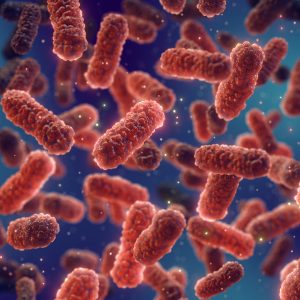Stabilizing antimicrobial peptides for the treatment of drug-resistant bacterial infections

Given the growing demand for effective antibacterial strategies, researchers are constantly exploring innovative materials and techniques to combat the rise of drug-resistant bacterial pathogens.1 For example, numerous studies have explored the potential of antimicrobial peptides (AMPs) for the treatment of antibiotic-resistant bacterial wound infections, which may pose significant health risks.2,3 AMPs, which are an integral part of the innate immune system, are short, positively charged amphiphilic peptides that selectively target the negatively-charged surfaces of Gram-negative and -positive bacteria, enveloped viruses, and fungi.4,5 Therefore, AMPs exhibit broad-spectrum antimicrobial activity while maintaining low toxicity towards mammalian cells, which have a net neutral charge. There is also evidence to suggest that AMPs can retain their antibacterial properties through contact killing, whereby bacterial cells that come into contact with the material surface are effectively eliminated.6,7
Despite the inherent antimicrobial potency of AMPs, factors such as proteolytic degradation, inhibition caused by high ionic concentrations, and interactions with serum components, contribute to their limited stability.8,9 A previously investigated method of addressing such stability concerns was to encapsulate the AMPs within carriers in the form of nanoparticles or wound dressings, to provide protection until their release. Nevertheless, upon delivery from the carrier system, the AMPs were still found to be vulnerable to interactions with serum components and ensuing enzymatic degradation.10 To overcome the aforementioned challenges, as well as to enhance serum stability and antibacterial efficacy, researchers have begun to explore additional protection for AMPs by conjugating them with novel materials, for effective utilization in wound dressings and catheters.
In a recent study by Blomstrand and colleagues, AMPs were covalently bonded to micro-sized antimicrobial lyotropic liquid crystal (LLC) particles that are capable of functioning in both solution and solid-state mediums.11 The LLC particles were formed through the self-assembly of Pluronic F-127, a block copolymer, and structurally and chemically analyzed using techniques such as dynamic light scattering, small-angle X-ray scattering, and Raman and Fourier transform infrared spectroscopy.11 The AMP-infused cross-linked LLC particles were subjected to in vitro biocompatibility, antibacterial and serum stability tests; the mode of action was studied by employing cryogenic transmission electron microscopy (cryo-EM).11
Salient findings of the study included11:
- The liquid crystal structure within the particles was retained along with covalently bonded AMPs, confirmed by material characterization studies.
- The LLC particles exhibited a broad size distribution, with a major population in the range of 90 nm–30 µ
- The high surface area of the smaller-sized LLC particles loaded with AMPs may facilitate better penetration into microbial cells or biofilms and sustained antimicrobial activity through uniform distribution.
- Experimental findings revealed that AMP functionalization does not have a major impact on the size of the LLC particles.
- The developed LLC antimicrobial particles with covalently bonded AMPs displayed nil cytotoxic or hemolytic effects, indicative of their biocompatibility.
- As revealed by in vitro bacterial assays, robust antibacterial efficacy of the novel antimicrobial particles was observed against a range of bacterial strains. These included Gram-positive bacteria, including aureus and S. epidermis and two methicillin-resistant S. aureus (MRSA) strains, as well as Gram-negative E. coli; there was less efficacy demonstrated against the more resilient P. aeruginosa strain.
- Covalent attachment of AMPs to the LLC particles improved their stability in serum, evident in the degree to which the bonded AMPs retained antibacterial activity against epidermidis, when compared with free AMPs.
- The AMP-bonded LLC particles demonstrated effective antibacterial properties that lasted for 2 days; free AMPs appeared to lose their antibacterial potency within a day.
- The mode of action of the bonded AMPs, as revealed by cryo-EM analysis, appeared to involve close interaction with the bacterial membrane, potentially leading to membrane disruption (contact-killing).
In summary, the developed AMPs exhibited excellent biocompatibility, broad-spectrum antibacterial activity and improved stability in serum when bonded with LLCs.11 The functionalization of LLC particles with AMPs not only preserved the peptides’ intrinsic bioactivity but also facilitated targeted delivery via controlled release to specific sites of infection. This targeted approach may minimize off-target effects, reduce dosage requirements, and potentially help combat the ever-evolving drug resistance profiles of bacterial pathogens.
References
- World Health Organization. Report signals increasing resistance to antibiotics in bacterial infections in humans and need for better data. Available at https://www.who.int/news/item/09-12-2022-report-signals-increasing-resistance-to-antibiotics-in-bacterial-infections-in-humans-and-need-for-better-data. Accessed 4 July 2023.
- Patrulea V, Borchard G, Jordan O. Pharmaceutics 2020; 12(9):840.
- Mangoni ML, McDermott AM, Zasloff M. Exp Dermatol 2016;25:167–173.
- Selsted ME, et al. J Clin Investig 1985;76(4):1436–1439.
- Shai, Y. Peptide Sci: Original Res Biomol 2002;66(4):236–248.
- Lim K, et al. Acta Biomater 2015;15:127–138.
- Zhu J, et al. Chem Mater 2019;31(12):4436–4450.
- Kim H, et al. J Antimicrob Chemother 2014;69(1):121–132.
- Nguyen LT, et al. PLoS ONE 2010;5(9):e12684.
- Håkansson J, et al. J Antibiot 2021;74(5):337–345.
- Blomstrand E, et al. Int J Pharm 2022;627:122215.










